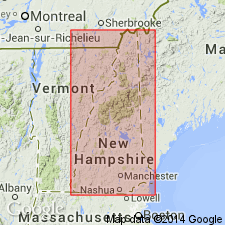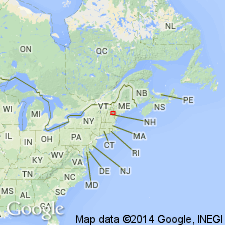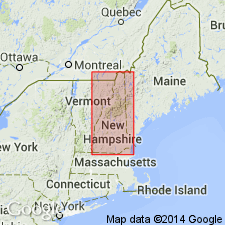
- Usage in publication:
-
- Conway Granite*
- Modifications:
-
- Age modified
- Geochronologic dating
- AAPG geologic province:
-
- New England province
Summary:
Page F2 states that the White Mountain Plutonic-Volcanic Series has an age of Late Triassic or Early Jurassic. Isotope age determination by Tilton and others (1957) and Hurley and others (1960) yields an age of 180 m.y. [It is unclear how 180 m.y. translates into Late Triassic or Early Jurassic. The ages of the Conway Granite, Mount Osceola Granite, Mount Lafayette Granite Porphyry, Mount Garfield Porphyritic Quartz Syenite, and the Albany Quartz Syenite are inferred to be Late Triassic or Early Jurassic.]
Source: GNU records (USGS DDS-6; Reston GNULEX).

- Usage in publication:
-
- Conway Granite
- Modifications:
-
- Geochronologic dating
- AAPG geologic province:
-
- New England province
Summary:
Radiometric ages, using K-Ar methods on biotite in Conway granite are 183 +/-5 Ma, 182 +/-4 Ma, 180 +/-4 Ma, 178 +/-4 Ma, 171 +/-4 Ma, and 155 +/-4 Ma.
Source: GNU records (USGS DDS-6; Reston GNULEX).

- Usage in publication:
-
- Conway Granite*
- Modifications:
-
- Revised
- Age modified
- Geochronologic dating
- AAPG geologic province:
-
- New England province
Summary:
Conway Granite used only for exposures of biotite granite previously mapped as Conway Granite near Redstone, NH, in the White Mountain batholith. Other bodies of similar granite within and outside the batholith are called Conway-type granite. Age is Early, Middle, and Late Jurassic based on K-Ar biotite dates reported by Eby and others (1992) of 183 +/-5 Ma from body of Conway at near Redstone, and five dates ranging from 182 +/-4 Ma to 171 +/-4 Ma from Conway-type granites from five other localities within White Mountain batholith; time scale of Harland and others (1989) is followed. Report includes geologic map, cross sections, and correlation chart.
Source: GNU records (USGS DDS-6; Reston GNULEX).

- Usage in publication:
-
- Conway Granite*
- Modifications:
-
- Overview
- Age modified
- Geochronologic dating
- AAPG geologic province:
-
- New England province
Summary:
Used as Conway Granite of White Mountain Plutonic-Volcanic Suite. Described as typically pink, coarse-grained, locally fine-grained or porphyritic mesoperthitic biotite (amphibole-free) granite. Age changed from Middle Jurassic to Middle and Late(?) Jurassic based on the following isotopic ages:
188 +/-5 Ma (U-Pb) citing Tilton and others (1957);
177 Ma (Rb-Sr; biotite) citing Aldrich and others (1957);
134-180 m.y. (Rb-Sr; biotite) citing Aldrich and others (1958);
173 +/-8 Ma (Rb-Sr; biotite) citing Hurley and others (1960);
181 +/-4 Ma (K-Ar) citing Hurley and others (1960);
169 +/-3 Ma (K-Ar) citing Foland and others (1971);
169 +/-3 Ma (K-Ar) and 181 +/-4 Ma (K-Ar) citing Foland and Faul (1977);
196, 193, 186, and 175 Ma (Rb-Sr; biotite) and 185 Ma (Pb-Pb) citing Eby and Creasy (1983);
183 +/-5, 182 +/-4, 180 +/-4, 178 +/-4, 171 +/-4, and 155 +/-4 Ma (K-Ar) citing Eby and others (1992); and
177 +/-5 Ma (K-Ar) citing Eby and others (in press).
Report includes geologic map and correlation chart, and 1:500,000-scale map showing plutons and sample localities for age dating.
Source: Modified from GNU records (USGS DDS-6; Reston GNULEX).
For more information, please contact Nancy Stamm, Geologic Names Committee Secretary.
Asterisk (*) indicates published by U.S. Geological Survey authors.
"No current usage" (†) implies that a name has been abandoned or has fallen into disuse. Former usage and, if known, replacement name given in parentheses ( ).
Slash (/) indicates name conflicts with nomenclatural guidelines (CSN, 1933; ACSN, 1961, 1970; NACSN, 1983, 2005, 2021). May be explained within brackets ([ ]).

